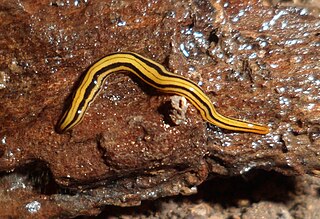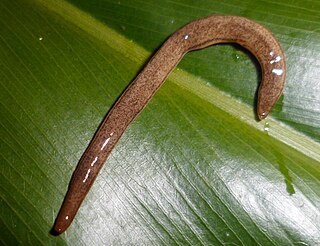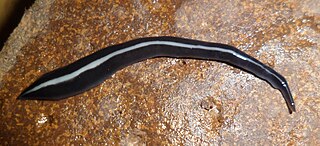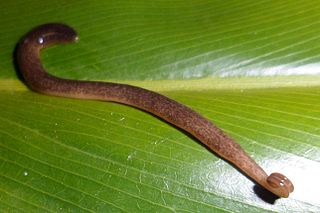
Luteostriata is a genus of land planarians from Brazil characterized by a yellow body with dark longitudinal stripes.

The reproductive system of planarians is broadly similar among different families, although the associated structures can vary in complexity.

Supramontana is a genus of land planarians from South America.

Paraba is a genus of land planarians from South America.

Endeavouria is a monotypic genus of land planarians from the Pacific region. It contains a single species, Endeavouria septemlineata.
Eudóxia Maria Froehlich was a Brazilian zoologist.

Luteostriata abundans is a species of Brazilian land planarian in the subfamily Geoplaninae. It is a common species in human-disturbed areas in Brazil's southernmost state, Rio Grande do Sul.

Imbira guaiana is a species of land planarian in the subfamily Geoplaninae. It is the type species of the genus Imbira and is found in Brazil.

Paraba franciscana is a species of land planarian found in Brazil.

Luteostriata graffi is a species of Brazilian land planarian in the subfamily Geoplaninae.

Luteostriata ernesti is a species of Brazilian land planarian in the subfamily Geoplaninae.

Supramontana irritata is a species of Brazilian land planarian in the subfamily Geoplaninae. It is the type species of the genus Supramontana.
Eudoxiatopoplana is a genus of land planarians from New Zealand, currently comprising a single species, Eudoxiatopoplana bilaticlavia, that occurs in Stewart Island. It is the sole genus of the tribe Eudoxiaotopoplanini.

Cephaloflexa araucariana is a species of land planarian in the subfamily Geoplaninae found in Brazil.

Choeradoplana iheringi is a species of land planarian in the subfamily Geoplaninae found in Brazil.
Cratera crioula is a species of land planarian belonging to the subfamily Geoplaninae. It is known from specimens found in Cantareira State Park, Brazil.
Choeradoplana bocaina is a species of land planarian belonging to the subfamily Geoplaninae. It is found in areas within the Atlantic Forest in Brazil, such as Serra da Bocaina National Park.
Choeradoplana gladismariae is a species of land planarian belonging to the subfamily Geoplaninae. It is found in areas within the Atlantic Forest in Brazil, such as the Intervales State Park.

Choeradoplana eudoxiae is a species of land planarian belonging to the subfamily Geoplaninae. It is known from specimens found in the São Francisco de Paula National Forest in Brazil.
Luteostriata subtilis is a species of land planarian belonging to the subfamily Geoplaninae. It is known from specimens found in Brazil.












